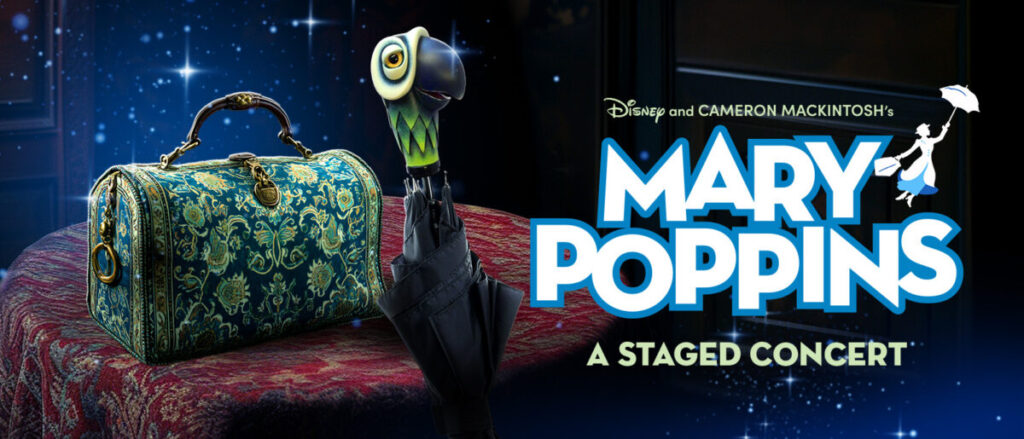
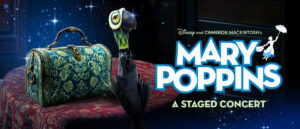 *** Bouncy and jubilant, “Mary Poppins: A Staged Concert” recalls the magic of the classic P. L. Travers tale, where a rare and remarkable nanny with a lovely singing voice (Laura Sportiello) comes to the aid of the staunchly middle class Banks family, who live in a large house on Cherry Tree Lane. Cameron Mackintosh’s stage adaptation of the 1964 Disney film forms the basis for the current musical, whose original music and lyrics were written by Richard M. Sherman and Robert B. Sherman with new songs and additional music and lyrics by George Stiles and Anthony Drewe. Considering that this show not only features the talent of the Metropolis Theatre but also their very own School of the Performing Arts, it is an extraordinary piece of work. Director Danny Kapinos has done a fine job working with the professional actors plus the children and the orchestra in bringing this entire production together in such a short period of time. What a talented group of people!
*** Bouncy and jubilant, “Mary Poppins: A Staged Concert” recalls the magic of the classic P. L. Travers tale, where a rare and remarkable nanny with a lovely singing voice (Laura Sportiello) comes to the aid of the staunchly middle class Banks family, who live in a large house on Cherry Tree Lane. Cameron Mackintosh’s stage adaptation of the 1964 Disney film forms the basis for the current musical, whose original music and lyrics were written by Richard M. Sherman and Robert B. Sherman with new songs and additional music and lyrics by George Stiles and Anthony Drewe. Considering that this show not only features the talent of the Metropolis Theatre but also their very own School of the Performing Arts, it is an extraordinary piece of work. Director Danny Kapinos has done a fine job working with the professional actors plus the children and the orchestra in bringing this entire production together in such a short period of time. What a talented group of people!
The tale of “Mary Poppins” is as follows: Mr. George Banks (Drew Longo) and his wife Winifred (Meghan McCandless) decide to hire a nanny to take care of their children Jane (Eleanor Merrick/Genevieve Jane) and Michael (Molly Hamada/Lanah Vurnakes). When the children write about the qualities that they hope to find in their new nanny, a young woman named Mary Poppins descends from the heavens (with her umbrella) to help care for them—and in so doing, she encourages warmth and tenderness throughout the entire family. She teaches the children (and eventually their parents) that being a good person and caring about people of all social classes is far more important than judging them on the basis of appearances and on the amount of money they have. Mary leads the children from one adventure to another together with her good friend Bert the chimney sweep (marvelously acted by Evan Bradford in dance and song). The two of them instruct the children to view the world around them in a magical way: from having them visit statues in a public park (and imagine what it might be like if the statues were real people) to teaching them how to fly a kite. Above all, they give the children permission to sing happy songs and to think about how it might feel to fly like a bird in flight above the city of London, with its brilliant electric lights shining at night. Here the joy of childhood is mixed with the joy of adults thinking back to what a child’s life might be, unencumbered by responsibilities. But basically, the story has to do with the reforming of Mr. Banks, who once had a nanny to raise him, named Miss Andrew (Rachel Carreras). She was the one who taught him strictness and precision when it comes to financial matters. When we are introduced to her later in the show, we can observe how her mean and exacting ways compare to those of the remarkably kind and gentle Mary Poppins. Mary’s whimsical and unusual way of viewing the world comes alive in such happy songs as “A Spoonful of Sugar Makes the Medicine Go Down” and “Supercalifragilisticexpialidocious.” And then there’s my all-time favorite “Chim Chim Cher-ee” where Mary and Bert dance together as if they float on air. The duo of Sportiello and Bradford is smashing!
In fact, the choreography by Tiffany Gates is gorgeous throughout. I loved how the large numbers incorporated some many young people and highlighted their acting and dancing skills, all with the assistance of dance captains Morgan Schoenecker and Rachael Dec. Plus, the constant resetting of the stage using portable chairs, a trunk, wooden boxes, and a model of the Banks’ house is so smoothly and cleverly done! This seamlessness is a credit to director Kapinos. The audience truly enjoyed the two different puppeteers holding the pet dog and making him bark; plus, having actors imitate a statue and a lark is really great. Fanning the pages of small books to imitate the fluttering of birds is genius! Dialect coach Kati Schwaber has neatly imparted British accents among the cast, making the performance quite realistic. And needless to say, the 16-piece JAM Orchestra, which backed the singers and dancers, could not have been any better! Conductor Aaron Kaplan and his musicians have done a marvelous job, and the original orchestrations by William David Brohn are exceptional.
Yet there are a few too many problems with this show. At 2 hours and 40 minutes including an intermission, the musical is much too long and drawn out. While the content might be suitable for children five and up, the presentation is tedious: No child can sit through it all, what’s more fully understand the story. Allow me to provide an example: On opening night, there were about eight people who knew each other seated in rows E and F. They had little kids between the ages of four and six. Not only were the kids bouncing around throughout the performance but, with the exception of the lively dance numbers, they couldn’t focus on what was happening. Eventually, the mothers gave each of the kids a cell phone and had them sit on the floor and play with it from underneath their seat. It was no surprise that this group of people left at halftime. Other people took their spots. Now I saw a girl about eight-years old fall asleep during the second act: to be awakened on occasion by applause. I realize that this was an evening show and past most children’s bedtimes. But from my observation, the kids in the audience were simply not being engaged enough.
Then too, the script suffers from not being adequately rooted in history. Totally omitted is any reference to women’s suffrage and the suffragettes (suffragists) between 1910 and 1919: a movement which once engaged Mrs. Banks. Without this background, we don’t fully understand the era and the importance of women’s rights—and the fact that women do not necessarily have to be wives, mothers, and nannies. What adds to the time confusion is the costuming. Yes, Mary Poppins’ trademark long red coat and blouse and skirt and flat-topped hat are of the proper time period, and Hubert’s chimney sweep outfit works well. However, practically everybody else’s outfit spanned the fashions between 1920 and the present-day, and it would have been helpful if all the women’s hemlines were below the knee (if not down to the floor). Plus, having children in the ensemble wear black or navy blue skirts or trousers would have produced some measure of conformity. Initially, I couldn’t figure out why Jane had one white sock up to the knee and the other one up to her calf. It didn’t suit her character, and it made her look sloppy. Apparently one of her socks had fallen, which was remedied between the first and the second act.
Bill Franz’s sound design is very good, considering the mix between the vocals and the orchestra. Because there are no sets in this production, it’s the lighting design by Dan Frank that differentiates scenes and moods. A screen behind the orchestra changes colors depending on the setting. One or more spotlights would come on whenever an important song was to be sung. That being said, the show could have used a projection designer in addition to better anchor most of the settings. For example, we never come to understand the need for chimney sweeps in the first place, because we never really see chimneys above and beyond those in our imagination. Yes, we see stars and some images of London, but these could have been accomplished with more perfection and precision.
If you can imagine “Mary Poppins” as an operetta, then this musical might appeal to you. The music is great; the dancing is marvelous; and the directing and music directing are great. But the script needs to be better grounded in history and real life rather than just the fantasy world. As things stand, it is much too scattered and repetitive. There is no need to introduce so many additional characters and unnecessary subplots (like introducing Miss Andrew as a character and having Mary Poppins initially leave the household at the end of the first act). Most importantly, there are far too many reprises of well-known songs from the original Disney movie. Inasmuch as I love hearing these songs, repeatedly singing them doesn’t make the show any better but, rather, detracts from it. At a time when most plays have been retooled to make them shorter and sharper, this one is the exception. It could have piqued our interest far more had it been a 90-minute one-act presentation that remained truer to its roots.
Disney and Cameron Mackintosh’s “Mary Poppins: A Staged Concert” is playing through March 9, 2025, at The Metropolis Performing Arts Centre, 111 W. Campbell Street, in Arlington Heights, Illinois.
Tickets: Regular A-level $45, Regular B-level $40, Students $24
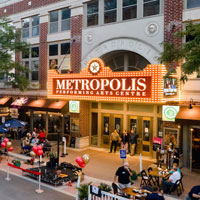 Performance schedule:
Performance schedule:
Thursdays, Fridays, and Saturdays at 7:30 p.m.
All Sunday matinee shows have already been sold out!
Accessible performances:
American Sign Language interpreted performance: Thursday, March 6, 2025 at 7:30 p.m.
Open Caption performance: Saturday, March 8, 2025 at 7:30 p.m.
For more information and to purchase tickets, go to https://www.metropolisarts.com/event/mary-poppins/ or call the Box Office at 847-577-2121.
To see what others are saying, visit www.theatreinchicago.com, go to Review Round-Up and click at “Mary Poppins: A Staged Concert”.


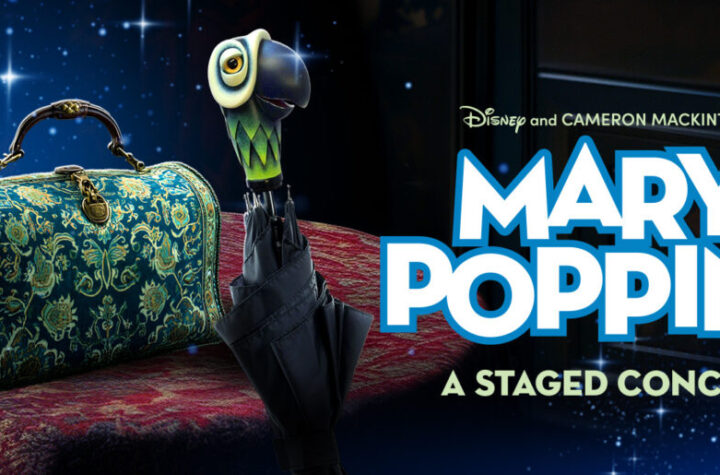

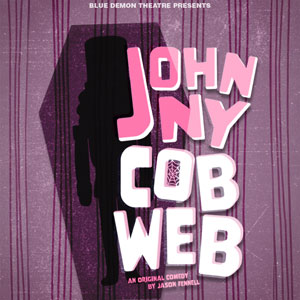

More Stories
” I and You”
“Johnny Cobweb” reviewed by Mark Reinecke
“Waitress”